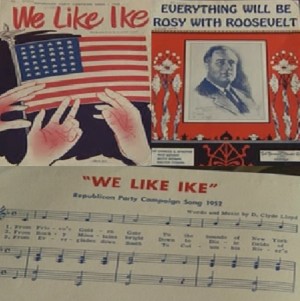See You At The Voting Booth: Political Search & Display Strategies
Political ad campaigns are far from a new concept. A quick scan of The Living Room Candidate provides a look at the rich historical legacy of television ads for presidential campaigns, ranging from the earliest days of television to today’s sophisticated :30 spots. Even before television spots were the norm, the DNC pioneered the use […]
Political ad campaigns are far from a new concept. A quick scan of The Living Room Candidate provides a look at the rich historical legacy of television ads for presidential campaigns, ranging from the earliest days of television to today’s sophisticated :30 spots.
Even before television spots were the norm, the DNC pioneered the use of the newfangled moving picture to produce Woodrow Wilson’s famous 1912 campaign film “The Oldway and the New.” A recent article in The New York Times even explained that in ancient Rome, negative campaigning was a well-established practice through the use of signs and graffiti.
Today’s explosion of online advertising technology is no different. Search and display media have offered the savvy campaigner new ways to place messages in front of voters.
Display advertising now allows candidates to reach millions of viewers for mere pennies, and all with the precision of a surgeon’s scalpel.
Through display advertising, candidates are able to target voters based on a wide variety of factors, including voting record and party affiliation, among others.
Facebook even provides elaborate targeting options, while search advertising allows candidates to target voters based on location, keywords and other factors.
Search advertising has also shown a healthy ROI for fundraising; a prime example is Ted Cruz’s campaign in Texas, which easily achieved a 10-to-1 return in fundraising dollars.
The use of social media to engage potential supporters has revolutionized modern campaigning and is typically credited with being a key factor in helping President Obama win the 2008 presidential election.
Today, I suspect that some politicians have also tapped into search retargeting to influence voters, taking advantage of the ability to reach consumers with high impact creative messages, alongside tailored advertisements based on search history.
A politician seeking a digital media edge should also turn to his/her party for strategies. Partisan initiatives such as the “National Voter File Co-op”, SmartVAN and Precision Network offer the Democratic candidate the same sophisticated targeting and real-time bidding tools used by the savviest digital marketers. They can precisely target voters who have identified themselves as Democrats via the National Voter File Co-op. The GOP also has a variety of technological choices.
For example, Targeted Victory has a number of partnerships that assure that the GOP candidate has access to a similar set of tools. In addition, there are dozens of non-partisan organizations that can help in a variety of different ways. Take a look at the resources section of Campaigns and Elections magazine for a quick rundown.
So, whether you’re running for office for the local school board or aspiring to run for a higher office, keep the following tips in mind:
Use search and display together
Targeted advertising can be your secret weapon if you use it the right way. If you combine the precision of search with the scale of display, you will create a properly crafted campaign that can reach people more effectively for a lower cost.
Have a solid social media strategy in place
Blogs, Twitter, Facebook and Google+ are all important social platforms because you will be able to engage with both voters and influencers. Social media has the ability to reach target audiences in a way that other channels sometimes can’t.
Engage with experts in the online marketing field
From social media consultants to interactive agencies, there is a wealth of knowledge out there, so seek out and use their advice. Campaigns of all sizes should explore the innovative ideas and various approaches to media previously mentioned, and can best do so with assistance from experts.
The real advantage that the online world has over traditional media is the ability to measure response and target effectively. Search, display and social mediums all enable this for marketers. Dig into what tactics are working and which are not to constantly evolve your digital campaign strategy and maximize your return.
Good luck, and see you at the voting booth!
Contributing authors are invited to create content for Search Engine Land and are chosen for their expertise and contribution to the search community. Our contributors work under the oversight of the editorial staff and contributions are checked for quality and relevance to our readers. The opinions they express are their own.
Related stories
